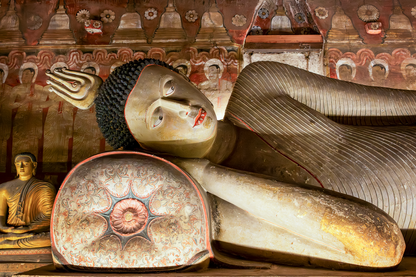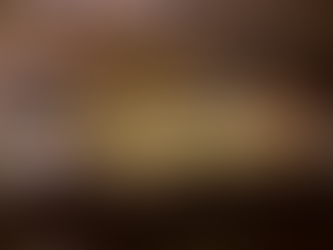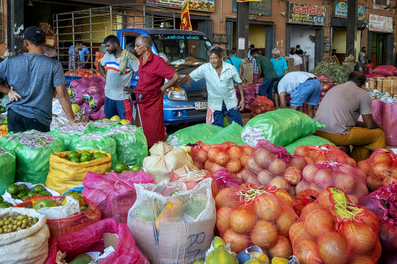Dambulla, Sri Lanka: March 28, 2024
- Cecilia Clark

- Mar 29, 2024
- 3 min read
Updated: Apr 12
The Dambulla temple complex consists of five caves of varying sizes and decoration that date back to the 1st century BC. The caves were built at the base of a 492 ft/150 m high rock during the Anuradhapura (1st century BC to 993 AD) and Polonnaruwa times (1073 to 1250). It took us about 30 minutes to climb the 200 steps to the temple complex. Offerings of beautiful Lotus flowers were for sale near the top. We left our shoes at the shoe kiosk and proceeded barefooted to the temple complex.
Cave 1, Cave of the Divine King, is from the 1st century BC. While it isn't very large, it does have a 46 foot/14 m statue of the Reclining Buddha hewn out of the rock. I have a long way to go to be able to decipher the gestures assigned to the Buddha; the feet are in the parinirvana (nirvana after death) pose with the upper leg (left) slightly back from the right foot but the Buddha's eyes are open.
Cave 2, called Cave of the Great Kings because there are statues of two kings, is the largest of the five caves. The cave measures about 171 ft/52 m from east to west, and 75 ft/23 m deep from the entrance to the back, and at its highest point it is 23 ft/7 m. The tempera paintings that cover every inch of the ceiling date from the 18th century and depict scenes from Buddha's life. The reclining Buddha is hewn from the rock. This cave has a stupa surrounded by meditating Buddhas. After the Buddha achieved enlightment under the Bodhi tree, he meditated for 7 days. On the 7th day, a naga (multi-headed, hooded Cobra-like snake) used its hood to protect Buddha from a storm. Another interesting feature for me was a statue of the Future Buddha. Indika said he knew it was the future Buddha because the statue's headdress has the image of Buddha on it. He is holding his hands in the "determination" mudra (despite the broken fingers). The Future Buddha looks like he has seen the future and we all should be very afraid of what is to come.
Cave 3, Great New Monastery acquired ceiling and wall paintings in the typical Kandy style during the reign of King Kirti Sri Rajasinha (1747–1782). In addition to about 50 Buddha statues, there is a statue of King Kirti Sri Rajasinha wearing clothing much too hot for Sri Lanka and probably obtained from the Dutch (1658-1796).
Caves 4 and 5 are quite small, relatively new, and so crowded I didn't linger in them. Because these are temples, there are monkeys here. Signs warn not feed the monkeys because you could be mobbed and robbed by them. Between our visit to Cave 2 and 3 everyone had to leave the temples for 15 minutes or so because there was going to be a service. While we were all outside waiting for the doors to reopen, we watched toque macaques climb over a fence with a "Caution High Voltage" sign and come our way to see if there were any tourists who hadn't heeded the warnings.
Before our visit to the Dambulla Cave Temple, Indika had another "off itinerary" stop for us. We stopped at the Dambulla Dedicated Economic Center. It is the largest wholesale fruit/vegetable market in Sri Lanka. The market operates 365 days/year and 24 hours/day and it is very busy. Farmers bring their harvest to sell to the wholesaler; communities and markets come to the wholesaler to buy produce to sell. The market consists of at least three airplane hangars where the wholesalers have their offices. Two to three lanes of traffic (trucks, buses, and trollies) loaded with produce move through the hangars. People were constantly in motion unloading and loading produce. It was hectic, but an amazing sight.
Our next two nights are at the Santani Wellness Resort and Spa on a hilltop in tea country.










































































Comments